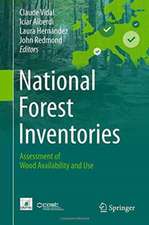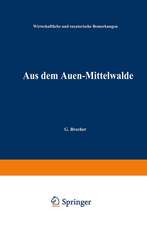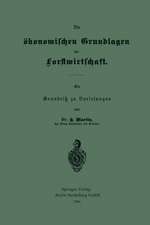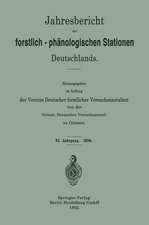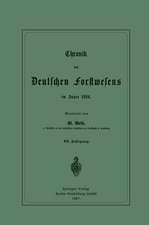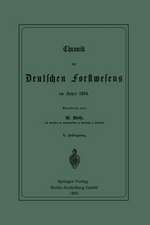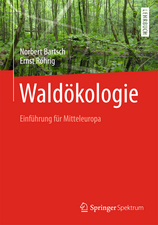Forest conservation in protected areas of Bangladesh: Policy and community development perspectives: World Forests, cartea 20
Editat de Mohammad Shaheed Hossain Chowdhuryen Limba Engleză Hardback – 30 iul 2014
| Toate formatele și edițiile | Preț | Express |
|---|---|---|
| Paperback (1) | 639.41 lei 6-8 săpt. | |
| Springer International Publishing – 17 sep 2016 | 639.41 lei 6-8 săpt. | |
| Hardback (1) | 645.60 lei 6-8 săpt. | |
| Springer International Publishing – 30 iul 2014 | 645.60 lei 6-8 săpt. |
Din seria World Forests
- 15%
 Preț: 646.43 lei
Preț: 646.43 lei - 15%
 Preț: 643.48 lei
Preț: 643.48 lei - 18%
 Preț: 1235.43 lei
Preț: 1235.43 lei - 18%
 Preț: 1225.94 lei
Preț: 1225.94 lei - 15%
 Preț: 631.53 lei
Preț: 631.53 lei - 18%
 Preț: 1233.37 lei
Preț: 1233.37 lei - 18%
 Preț: 947.35 lei
Preț: 947.35 lei - 18%
 Preț: 943.57 lei
Preț: 943.57 lei - 18%
 Preț: 946.41 lei
Preț: 946.41 lei - 18%
 Preț: 953.35 lei
Preț: 953.35 lei - 18%
 Preț: 1559.80 lei
Preț: 1559.80 lei - 15%
 Preț: 644.95 lei
Preț: 644.95 lei - 15%
 Preț: 640.06 lei
Preț: 640.06 lei - 18%
 Preț: 1223.55 lei
Preț: 1223.55 lei - 18%
 Preț: 730.35 lei
Preț: 730.35 lei - 18%
 Preț: 1107.56 lei
Preț: 1107.56 lei - 18%
 Preț: 1240.30 lei
Preț: 1240.30 lei - 18%
 Preț: 952.40 lei
Preț: 952.40 lei - 20%
 Preț: 552.13 lei
Preț: 552.13 lei - 18%
 Preț: 954.45 lei
Preț: 954.45 lei - 24%
 Preț: 779.25 lei
Preț: 779.25 lei - 24%
 Preț: 1058.46 lei
Preț: 1058.46 lei - 18%
 Preț: 943.57 lei
Preț: 943.57 lei
Preț: 645.60 lei
Preț vechi: 759.54 lei
-15% Nou
Puncte Express: 968
Preț estimativ în valută:
123.55€ • 134.16$ • 103.78£
123.55€ • 134.16$ • 103.78£
Carte tipărită la comandă
Livrare economică 23 aprilie-07 mai
Preluare comenzi: 021 569.72.76
Specificații
ISBN-13: 9783319081465
ISBN-10: 3319081462
Pagini: 300
Ilustrații: XVI, 258 p. 55 illus., 49 illus. in color.
Dimensiuni: 155 x 235 x 17 mm
Greutate: 0.56 kg
Ediția:2014
Editura: Springer International Publishing
Colecția Springer
Seria World Forests
Locul publicării:Cham, Switzerland
ISBN-10: 3319081462
Pagini: 300
Ilustrații: XVI, 258 p. 55 illus., 49 illus. in color.
Dimensiuni: 155 x 235 x 17 mm
Greutate: 0.56 kg
Ediția:2014
Editura: Springer International Publishing
Colecția Springer
Seria World Forests
Locul publicării:Cham, Switzerland
Public țintă
GraduateCuprins
1: Introduction.- 2: Conceptual framework, research methods and approaches.- 3: Critical analysis of the forest policy of Bangladesh: Highlights on conservation and people’s participation.- 4: Local communities’ use of biomass fuels and attitude towards improved cooking stoves in and around Rema-Kalenga Wildlife Sanctuary.- 5: Major resource use from protected areas by local communities: A case of harvesting medicinal plants in and around Rema-Kalenga Wildlife Sanctuary.- 6: Impact of co-management on rural development: Evidence from community survey in and around Rema-Kalenga Wildlife Sanctuary.- 7: Assessment of the community participation in and attitudes towards co-management programs in Rema-Kalenga Wildlife Sanctuary.- 8: Biodiversity conservation and ecosystem functions of indigenous agroforestry systems: Case study from three tribal communities in and around Lawachara National Park.- 9: Role of co-management organizations in protected area governance: Some selected dynamics from Chunati Wildlife Sanctuary.- 10: A review discussion on the state of collaborative protected area management around the world and comparison with that of Bangladesh.- 11: Potential threats, their patterns and extent to the protected areas of Bangladesh: A ‘red flag’ to biodiversity conservation efforts.- 12: Conclusion and recommendations.
Notă biografică
Dr. Mohammad Shaheed Hossain Chowdhury JSPS Post-Doctoral Research Fellow Wildlife Ecology Laboratory Education and Research Center of Alpine Field Science Faculty of Agriculture Shinshu University, Japan.
Textul de pe ultima copertă
This book is dealing with a number of issues under the broad subject matter of protected area focusing on the policy of collaborative management as a means to augment the forest conservation activities and enhance community development in Bangladesh. Comprehending the malfunction of traditional forest management in Bangladesh, the government explored and implemented few alternative strategies for better management of the country’s forest resources. Establishing protected areas was the first initiative of such strategy. But simple declaration of protected areas has not functionally worked in the prevention of forest degradation. Because, local communities face hardships after a forest is notified as protected area. This is mainly due to the imposing of strict regulations that curb the flow of forest resources for their livelihoods. Therefore, considering the pragmatism, the government started collaborative management approach with the active participation of local communities in five protected areas as pilot projects. Studies on the pilot sites, covered in the book emerged with the success stories of protected area co-management, both in terms of community development and biodiversity conservation. Significant level of development was noticed in the socio-economic conditions of the surrounding communities as an impact of this new strategy. Empowerment and improved social dignity of women participants signifies the initiation of co-management approach. The principles of participatory governance were found reasonably well reflected in legal and policy frameworks. Based on the lessons from the studies, a general metaphysical model, namely ‘Spider-web model of protected area co-management’ has been developed that can be potentially applicable in countries where local communities rely heavily on protected areas. We hope that the contents of the book provide useful information for policy makers developing more comprehensive programs for protected areamanagement in Bangladesh
Caracteristici
The book covers as many aspects of participatory protected area management as possible This is a success story of implementing conservation policy in Bangladesh. However, it does not only focus on the positive issues, but also highlights the adverse ones. For instance, negative attitude of the community people towards ‘Improved Cooking Stove’ that is generally welcomed worldwide. This is a controversial but interesting finding, which could be of interest for the researchers working in biomass energy A meta-physical model (‘Spider-web model of protected area co-management’) has been developed, which could be followed by the policy makers of countries having similar socio-economic and geo-political context like Bangladesh Includes supplementary material: sn.pub/extras







